Advanced Pharmacology 6521 Mid Term Exam 2022 Questions and Answers
Document Content and Description Below
Anti-diarrheals - ANSWER Stops further occurrence of diarrhea. Notable medicines are Loperamide "Immodium", Diphenoxylate Hcl with Atropine "Lomotil", Bismuth subsalicylate "Pepto bismul" Pepto s/e: ... black stools and tongue Laxatives - ANSWER Used to ease or stimulate defecation Soften the stool Increase stool volume Hasten fecal passage through the intestine Facilitate evacuation from the rectum *Misuse comes from misconceptions of what constitutes normal bowel function Fiber Laxatives - ANSWER absorbs water, softening feces and increasing their mass. Can be digested by colonic bacteria, whose subsequent growth increases fecal mass. ex. Bran, veggies and fruits. Meds: mehylcellulose, psyllium, polycarbophil Surfactant Laxatives - ANSWER Meds: Docusate sodium (Colace) Docusate calcium (Surfak) temporary treatment of constipation * avoid if narrowing of intestines Give with a full glass of water or juice Stimulant Laxatives - ANSWER bisacodyl: (tablets: give at night to have BM in am , no crushing or chewing, no milk or antacids;Suppositories: BM within 15-60 min, may cause proctitis); senna: BM 6-12 hours after. May cause pink or brown urine. castor oil: acts on small intestine 2-6 hour BM. Limit to only when prep for radiology procedures. Chill and mix in juice. * easily abused, Give with a full glass of water. Osmotic Laxatives - ANSWER Salts draw water into the intestine causing fecal mass to soften and swell stimulating peristalsis. Low dose 6-12 hours, high dose 2-6 hours. magnesium hydroxide, magnesium citrate, polyethylene glycol, lactulose (can be used to lower blood ammonia in liver disease) * Increase fluid intake. Not good for kidney disease. Sodium phosphate exacerbates cardiac disease. Miscellaneous Laxatives - ANSWER Lubiprostone, mineral oil, glycerin suppository, polyethylene glycol- electrolyte solution, Sodium picosulfate / magnesium oxide/anhydrous citric acid antiemetic - ANSWER a medication that is administered to prevent or relieve nausea and vomiting Ondesetron Class: 5HT3 receptor antagonist - ANSWER Zofran Indication: Chemotherapy N/V, postoperative N/V, radiation induced N/V Oral or Parental * Prolonges QT interval (leading to torsades de pointes) Glucocorticoids used as antiemetic - ANSWER Not approved by FDA. Solumedrol and dexamethasone. Given IV. Metoclopramide (Reglan) - ANSWER controls post-op NV suppresses emesis and increases upper GI mobility Cannabinoids - ANSWER Dronabinol (marinol) and Nabilone (cesamet). Suppresses CINV. Alosetron (Lotronex) - ANSWER Used for IBS-D in women that has lasted > 6 months Blocks 5-HT3 receptors resulting in firm stool and decrease in urgency and frequency of defecation Can cause constipation PPIs - ANSWER Proton-pump inhibitors - pronounced and long-lasting reduction of gastric acid production - destroyed by stomach acid (take on empty stomach) - work really well - "attack from the back" - used as a controller Ex. Omeprazole (Prilosec) Mesalamine - ANSWER treats ulcerative colitis Ranitidine (Zantac) - ANSWER H2 receptor antagonist. Potent inhiitor of gastric acid secretion Indications: GERD, ulcers, H. pylori, reflux, indigestion ADR: Pain, constipation, diarrhea, headache. Can cause jaundice Ulcers treatment - ANSWER likely caused by H. pylori. Treat with antibiotic and pepto bismol, proton pump inhibitors (prilosec, prevacid, aciphex, nexium, protonix), H-2 blockers (zantac, pepcid, tagamet, nazatidine), antacids, and cytoprotective agens (carafate, cytotec) irritable bowel syndrome (IBS) - ANSWER periodic disturbances of bowel function, such as diarrhea and/or constipation, usually associated with abdominal pain. Intermittent diarrhea and constipation with pain. Treat and prevent symptoms: Antispasmodics, bulk forming agents, antidiarreheals and tricyclic antidepressants. Alosetron (Lotronex) - ANSWER Used for IBS-D in women that has lasted > 6 months Blocks 5-HT3 receptors resulting in firm stool and decrease in urgency and frequency of defecation Can cause constipation / bowel obstruction and perforation Eluxadoline (Viberzi) - ANSWER Mu/Kappa opioid receptor agonist and delta opioid receptor antagonist in the gut used to treat IBS prone diarrhea Lubiprostone (Amitiza) - ANSWER Used for IBS-C and chronic constipation Increases fluid secretion in intestine, promotes motility Can cause diarrhea, nausea (take w/ food) Crohn's disease - ANSWER a chronic autoimmune disorder that can occur anywhere in the digestive tract; however, it is most often found in the ileum and in the colon Sulfasalazine (Azulfidine) - ANSWER 5-aminosalicylate,, DMARD Decrease inflammation by inhibiting prostaglandin synthesis Used for IBD (Crohn's, UC), RA Can cause agranulocytosis, hemolytic and macrocytic anemia,, hepatic dusfunction, bone marrow suppression Mesalamine - ANSWER Treats ulcerative colitis and mild to moderate IBD Olsalazine (Dipentum) - ANSWER IBD Management - Salicylate Derivative Balsalazide (Colazal) - ANSWER IBD Management - Salicylate Derivative Cyclosporine - ANSWER Immunosuppressant Methyltrexate - ANSWER Immunossuppressant. Can promote short-term remission and reduce need for glucocorticoids in patients with Crohn's disease Immunomodulating drugs - ANSWER Medications that therapeutically alter a patient's immune response to malignant tumor cells Drugs that modify the body's own immune response so that it can destroy various viruses and cancerous cells Second line agents in inflammatory bowel. Infliximab (Remicade) - ANSWER Monoclonal Antibody that binds to tumor necrosis factor (TNF) & neutralizes its activity by preventing it from binding to the cell membrane in the blood. It is an immunosuppressant & is indicated for treatment of active Crohn disease & ulcerative colitis & is generally reserved for moderate - severe cases. It is given in IV form & the vials need to be refrigerated. Metronidazole (Flagyl) - ANSWER 1. Used to treat anaerobic infections 2. DO NOT USED ALCOHOL (antabuse effect will be nauseous) treats mild to moderate crohns diease. Ciprofloxacin (Cipro) - ANSWER Antibiotic, treats crohns, used with infliximab. Ulcer treatment - ANSWER usually includes medication to decrease stomach acid production like antacids; if bacteria is cause, antibiotics may be needed; avoid smoking and drinking Dextromethorphan - ANSWER -Antitussive (antagonizes NMDA glutamate receptors). -Synthetic codeine analog. Has mild opioid effect when used in excess. -Naloxone can be given for overdose. Mild abuse potential. -May cause serotonin syndrome if combined with other serotonergic agents 2nd generation antihistamines - ANSWER Fexofenadine, loratadine, and cetirizine non sedating less crossing of blood brain barrier, does not suppress CNS Take daily to prevent allergic reaction. First Generation histamine- 1 antagonists - ANSWER inhibit allergic reactions of inflammation, redness, and itching caused by the release of histamine Can be used with cold symptoms. Anticholinergic property (dry mouth, urinary hesitancy) CNS depressant (sleepiness) Caution in Asthmatic patients (thickens bronchial secretions impairing breathing) Ex. diphenhydramine, promethazine, chlorpheniramine Nasal Decongestants - ANSWER Shrink mucosal membranes and reduces fluid secretion, should not be used for more than 48 hours Afrin, Phenylephrine, pseudophedrine antitussives/expectorants - ANSWER Control cough, promote elimination of mucus Ex: dextromethorphan, codeine, guaifenesin Codeine (decreases the frequency and intensity of cough) Digoxin (Lanoxin) - ANSWER Cardiac glycoside Positive inotrope, negative chronotrope and dromotrope Used for HF, a-fib Can cause dysrhythmias, bradycardia, GI effects (EARLY), vision changes (EARLY) Hypokalemia = toxicity; hyperkalemia = decreased effects Avoid verapamil Hold if pulse < 60 Therapeutic level = 0.5-2.0ng/mL Antidote: cholestyramine or Digibind Interacts w/ many meds and bran, oats, sunflower seeds. Statins - ANSWER lower cholesterol in the blood and reduce its production in the liver by blocking the enzyme that produces it. Most effective. Reduces LDS and increases HDL. Oral, absorbed 30-90%. S/e: headache, rash, GI, muscle pain. Rhabdomyolysis - ANSWER dissolution of striated muscle (caused by trauma, extreme exertion, or drug toxicity; in severe cases renal failure can result) Hepatotoxicity - ANSWER damage to the liver. Elevated transaminase levels, jaundice (rare). Check LFT's. Avoid statins in alcohol-induced hepatitis. Colesevelam (Welchol) - ANSWER bile acid sequestrants used for antilipemic meds. bile acid sequestrants reduce LDL. Colestipol (Colestid) - ANSWER bile acid sequestrant (older agent). Decreases fat absorpion and may decrease uptake of fat-soluble vitamins. Nitroglycerin (Nitrostat) - ANSWER take up to 3 tabs during single episode place under tongue store in original container discard on expiration date May be taken on a schedule. Take prior to exercise / sexual activity Calcium Channel Blockers - ANSWER agents that inhibit the entry of calcium ions into heart muscle cells, causing a slowing of the heart rate, a lessening of the demand for oxygen and nutrients, and a relaxing of the smooth muscle cells of the blood vessels to cause dilation; used to prevent or treat angina pectoris, some arrhythmias, and hypertension Ex. Nifedipine, amlodipine, Nicardipine, Diltiazam, Verapamil No grapefruit juice, Nsaids ACE inhibitors - ANSWER "PRIL" ex. Captopril, Enalapril, Afosiopril Antihypertensive. Blocks ACE in lungs from converting angiotensin I to angiotensin II (powerful vasoconstrictor). Decreases BP, Decreased Aldosterone secretions, Sodium and fluid loss. Check BP before giving (hypotension) *Orthostatic Hypotension Diuretics - ANSWER medications administered to increase urine secretion in order to rid the body of excess water and salt Thiazide is first line for hypertension. Loop Diuretics are common - monitor for hypokalemia Beta Blockers - ANSWER decrease heart rate and dilate arteries by blocking beta receptors "olol" in the end. Ex. propanolol, atenolol, metoprolol Treat: Irregular heart rhythm (arrhythmia) Heart failure Chest pain (angina) Heart attacks Migraine Certain types of tremors May cause edema, fatigue, weight gain, depression Nitroprusside - ANSWER Short acting; increase cGMP via direct release of NO. Can cause cyanide toxicity (releases cyanide) a vasodilator that works by relaxing the muscles in your blood vessels to help them dilate (widen). This lowers blood pressure and allows blood to flow more easily through your veins and arteries. Given IV and titrated for therapeutic dose. Spironolactone (Aldactone) - ANSWER a potassium-sparing diuretic (water pill)that prevents your body from absorbing too much salt and keeps your potassium levels from getting too low. used to treat heart failure, high blood pressure (hypertension), or hypokalemia (low potassium levels in the blood). Furosemide (Lasix) - ANSWER loop diuretic (water pill) that prevents your body from absorbing too much salt. This allows the salt to instead be passed in your urine. Lasix is used to treat fluid retention (edema) in people with congestive heart failure, liver disease, or a kidney disorder such as nephrotic syndrome. Also used to treat high blood pressure High doses can cause hearing loss. Hydrochlorothiazide - ANSWER a thiazide diuretic (water pill) that helps prevent your body from absorbing too much salt, which can cause fluid retention. HCTZ treats fluid retention (edema) in people with congestive heart failure, cirrhosis of the liver, or kidney disorders, or edema caused by taking steroids or estrogen. This medication is also used to treat high blood pressure (hypertension). No digoxin or nsaids. Benzodiazepines - ANSWER The most common group of antianxiety drugs, which includes Valium and Xanax. Sedatives, Hypnotics, and Anxiolytics - ANSWER a.k.a. Mood Depressants. The word "Sedative = Calming, "Hypnotics = Sleep - inducing, "Anxiolytics = Decrease Anxiety. Buspirone (Buspar) - ANSWER anxiolytic Buspirone is an anti-anxiety medicine that affects chemicals in the brain that may be unbalanced in people with anxiety. Buspirone is used to treat symptoms of anxiety, such as fear, tension, irritability, dizziness, pounding heartbeat, and other physical symptoms. No MAOI Zaleplon - ANSWER Sedative/Hypnotic a sedative that is used to treat insomnia. zaleplon causes relaxation to help you fall asleep and stay asleep. Zolpidem (Ambien) - ANSWER insomnia Ambien, Edluar, and Zolpimist are used to help you fall asleep when you first go to bed. Intermezzo, is used to help you fall back to sleep if you wake up in the middle of the night and then have trouble sleeping. albuterol/ipratropium - ANSWER bronchodilator that relaxes muscles in the airways and increases air flow to the lungs. Albuterol inhalation is used to treat or prevent bronchospasm, or narrowing of the airways in the lungs, in people with asthma or certain types of chronic obstructive pulmonary disease (COPD). It is also used to prevent exercise-induced bronchospasm. Anticholinergics - ANSWER Atropine GI - Slows motility, spasm Eyes - Dilates pupils *DO NOT GIVE TO GLAUCOME PTS* Heart - Increase HR Resp - bronchodilator (Atrovent) Long Acting Beta Agonists (LABA) - ANSWER 1) Formoterol & Salmeterol 2) Onset 20 minutes so NOT for ACUTE attacks 3) Lasts up to 12 hours 4) *Never used alone in ASTHMA, always with inhaled corticosteroids* different with COPD. This is bc smart study showed that LABA alone for asthma can cause death. Inhaled Corticosteroids (ICS) - ANSWER fluticasone mometasone budesonide beclomethasone pref for persistent asthma need consistent daily use for optimal effect (NOT PRN) Theophylline - ANSWER a bronchodilator. It works by relaxing muscles in the lungs and chest, making the lungs less sensitive to allergens and other causes of bronchospasm. Theophylline is used to treat symptoms such as wheezing or shortness of breath caused by asthma, bronchitis, emphysema, and other breathing problems Tablet form: do not crush, chew or break open. Take with full glass of water. Zafirlukast - ANSWER eukotriene (loo-koe-TRY-een) inhibitor. Leukotrienes are chemicals your body releases when you breathe in an allergen (such as pollen). These chemicals cause swelling in your lungs and tightening of the muscles around your airways, which can result in asthma symptoms. Zafirlukast is used for chronic treatment of asthma, and to prevent asthma attacks in adults and children as young as 5 years old. Take on empty stomach 1-2 hours before eating. Do not prescribe for people with liver disease. Steroids in asthma - ANSWER Treat flair up intermittently. May cause irritability and increased hunger. Not long term Methylprednisone, prednisone, dexamethasone Gout - ANSWER hereditary metabolic disease that is a form of acute arthritis, characterized by excessive uric acid in the blood and around the joints Allopurinol - ANSWER reduces the production of uric acid in your body. Uric acid buildup can lead to gout or kidney stones. Allopurinol is used to treat gout or kidney stones, and to decrease levels of uric acid in people who are receiving cancer treatment. ex zyloprim, aloprim Given short term for flair up, and long term to prevent Rash is side effect - stop med. Etanercept (Enbrel) - ANSWER Disease-modifying antirheumatic drug (DMARD). Interrupts complex immune responses, preventing disease progression. Uses: slow joint degeneration and progression of rheumatoid arthritis. Sulfinpyrazone (Anturane) - ANSWER used in the treatment of chronic gout (gouty arthritis), which is caused by too much uric acid in the blood. The medicine works by removing the extra uric acid from the body. Sulfinpyrazone does not cure gout, but after you have been taking it for a few months it may help prevent gout attacks. Sulfinpyrazone will help prevent gout attacks only as long as you continue to take it. efficacy - ANSWER the ability to produce a desired or intended result effectiveness Pharmacokinetics - ANSWER The process by which drugs are absorbed, distributed within the body, metabolized, and excreted. Pharmacodynamics - ANSWER The process by which a medication works on the body. drug tolerance - ANSWER the tendency for larger doses of a drug to be required over time to achieve the same effect addiction - ANSWER A physiological or psychological dependence on a drug dependence - ANSWER the condition that results when the brain develops a chemical need for a drug and cannot function normally without it withdrawal - ANSWER the discomfort and distress that follow discontinuing the use of an addictive drug first pass effect - ANSWER The initial metabolism in the liver of a drug absorbed from the gastrointestinal tract before the drug reaches systemic circulation through the bloodstream. idiosyncratic response - ANSWER strange, unique, or unpredicted response to a drug medication reconciliation - ANSWER A procedure to maintain an accurate and up-to-date list of medications for all patients between all phases of health care delivery. FDA approval - ANSWER the FDA can prevent marketing of any drug it judges to be incompletely tested or dangerous. -only drugs considered to be safe by the FDA are approved for marketing. Digoxin reversal agent - ANSWER Digibind Opioid reversal agent - ANSWER Naloxone (Narcan) MedWatch Program - ANSWER This voluntary program encourages nurses and other health care professionals to use the MedWatch form to report when a medication, product, or medical event causes serious harm to a patient. Half-life of a medication - ANSWER the amount of time it takes for half of the drug to be eliminated. Liver and kidney disease, aging, absence of food, and slowed metabolic rate prolong half-life because of their effects on metabolism and excretion. Lithium - ANSWER affects the flow of sodium through nerve and muscle cells in the body. Sodium affects excitation or mania. Lithium is used to treat the manic episodes of bipolar disorder (manic depression). Manic symptoms include hyperactivity, rushed speech, poor judgment, reduced need for sleep, aggression, and anger. Lithium also helps to prevent or lessen the intensity of manic episodes. Check levels regularly lithium toxicity: muscle weakness, twitching, drowsiness, feeling light-headed, mood changes, blurred vision, ringing in your ears, irregular heartbeats, confusion, slurred speech, clumsiness. trouble breathing, or seizures. Methotrexate - ANSWER Immunosuppressant used to treat certain types of cancer or to control severe psoriasis or rheumatoid arthritis that has not responded to other treatments. It may also be used to control juvenile rheumatoid arthritis. (aka Rheumatrex) SE: nausea, feeling tired, fever, increased risk of infection, low white blood cell counts, and breakdown of the skin inside the mouth. Neuroleptic Malignant Syndrome (NMS) - ANSWER A rare and sometimes fatal reaction to high-potency neuroleptic drugs. Symptoms include muscle rigidity "lead pipe", fever, Sweating, autonomic instability and elevated white blood cell count. It is thought to result from dopamine blockage at the basal ganglia and hypothalamus. Treatment: supportive measures, drug therapy and immediate withdrawal of antipsychotic medication. Antipsychotics (neuroleptics) - ANSWER a class of psychotropic medications used for the treatment of schizophrenia and other disorders that involve psychosis. Ex. olanzapine, risperidone, haloperidol. MAOI Antineoplastics (anti-tumor) - ANSWER "Stine" cytotoxic systemic chemotherapy or targeted biological therapy; designed to target specific molecular components in tumor cell biology with the hope of minimizing cytotoxicity to noncancerous cells. Levothyroxine (Synthroid) - ANSWER thyroid hormone Don't switch brands Take for at least 3 weeks to see if effective. Take on empty stomach and don't eat or drink for at least 30 min. Methimazole (Tapazole) - ANSWER Thyroid hormone antagonist. Inhibits synthesis of thyroid hormone. Used for hyperthyroidism, preoperative thyroidectomy, thyrotoxic crisis, and thyroid storm. SSRIs - ANSWER selective serotonin reuptake inhibitors, used to relieve anxiety and depression by limiting reuptake of a neurotransmitter, takes about 3 weeks to work. Ex. end in [pram], [ine] citalopram [Celexa]; escitalopram [Lexapro]; fluoxetine [Prozac]; paroxetine [Paxil] Multiple Sclerosis (MS) - ANSWER destruction of the myelin sheath on neurons in the CNS and its replacement by plaques of sclerotic (hard) tissue Dantrium - ANSWER dantrolene Treats MS skeletal muscle relaxant. S/E constipation Glatirimer - ANSWER immunomodulator medication currently used to treat multiple sclerosis. Reduces relapses, does not stop progress of disease. Baclofen - ANSWER Muscle relaxant, GABAb receptor agonist, produces hyperpolarization by increased potassium conductance also used as an antispasmodic agent. Baclofen is used to treat muscle symptoms; such as spasm, pain and stiffness; caused by multiple sclerosis, spinal cord injuries, or other spinal cord disorders. It is given intrathecally (directly into the spinal cord) or orally (by mouth). Tizanidine (Zanaflex) - ANSWER - Central alpha 2 agonist; a short-acting muscle relaxer. It works by blocking nerve impulses (pain sensations) that are sent to your brain. (treats MS symptoms) S/E: Liver damage, Hypotension, Dizziness, xerostomia, weakness, QT prolongation * important * > Contraindicated with ciprofloxacin and fluvoxamine due to elevated tizanidine levels Disulfuram (Antabuse) - ANSWER Ethanol Aversion Agent buprenorphine/naloxone - ANSWER Suboxone. used to treat narcotic (opiate) addiction. Nicotene substitute - ANSWER Gum, patches, nasal sprays that deliver small amounts of nicotine when trying to give up the habit Antiepileptic Drugs (AEDs) - ANSWER Also known as anticonvulsants Goals of therapy -To control or prevent seizures while maintaining a reasonable quality of life -To minimize adverse effects and drug-induced toxicity -AED therapy is usually lifelong -Combination of drugs may be used Phenytoin (Dilantin) - ANSWER Anticonvulsant. SEs: Nysagmus, diplopia, EOM palsies, ataxia, gingival hyperplasia. Slows down impulses of the brain that cause seizure activity. Ethosuximide - ANSWER Absence seizures thalmic T type ca++ channel blocker Osteoporosis - ANSWER A condition in which the body's bones become weak and break easily. Treatment: Raloxifene - hormone that improves bone density Denosumab- hormone that prevents bone loss Biphosphonates: Alendronate · Ibandronate · Zoledronic acid. Prevents bone loss. Calcitonin - ANSWER Osteoporosis treatment: a man-made form of a hormone that occurs naturally in the thyroid gland. It increases deposition of calcium and phosphate in the bone and lowers levels in the blood, so effectively it inhibits calcium resorption by binding to a specific receptor on the osteoclasts, and inhibits their action. Hypoglycemics: Action - ANSWER Stimulates liver to change glycogen to glucose, used for hypoglycemia (when unconscious) Glucagon. Glyburide - ANSWER Stimulates insulin release from the pancreatic beta cells; reduces glucose output from the liver; insulin sensitivity is increased at peripheral target sites Glipizide (Glucotrol) - ANSWER Stimulates insulin release from the pancreatic beta cells; reduces glucose output from the liver; insulin sensitivity is increased at peripheral target sites Metformin - ANSWER Decreases hepatic glucose production, decreases intestinal absorption of glucose and improves insulin sensitivity (increases peripheral glucose uptake and utilization) Insulin - ANSWER A protein hormone secreted by the pancreas that is essential for the metabolism of carbohydrates and the regulation of glucose levels in the blood. Insulin Lispro: rapid acting Insulin Glargine: long acting insulin regular (Humulin R, Novolin R) - ANSWER - Short-Acting Insulin - Onset: 30-60 minutes - Peak: 2-4 hours - Duration: 5-7 hours - Nursing considerations: give 30-60 minutes before meal, can mix with NPH, ONLY insulin that can be given IV! Opioids (narcotics) - ANSWER are prescribed for moderate to severe pain. They are associated with respiratory depression and adverse effects of nausea, vomiting, constipation, itching, urinary retention, and altered mental processes. Sedation is an adverse effect of opioids that always precedes respiratory depression. muscle relaxants - ANSWER relieve muscle spasms and stiffness Possible side effects 1. Drowsiness or dizziness. 2. Possible addiction or dependence. 3. Dry mouth. 4. Urinary retention. NSAIDs - ANSWER nonsteroidal anti-inflammatory drugs S/E -Gastric ulcer/bleeding -Prolonged bleeding time (platelet interference) -Increased risk of cardiovascular events -Renal toxicity (including celecoxib) Acetaminophen (Tylenol) - ANSWER Analgesic S/E Anemia (long term use) Liver and kidney failure Dyspnea (prolonged high doses) angioedema hives, itching Topical lidocaine - ANSWER causes localized vasoconstriction, producing a white ring around the wound application area. The preparation provides anesthesia in the immediate are. Orlistat - ANSWER blocks some of the fat that you eat, keeping it from being absorbed by your body. Used to aid in weight loss, or to help reduce the risk of regaining weight already lost. This medicine must be used together with a reduced-calorie diet and increased physical activity. Orlistat is for use only in adults that are overweight or obese. S/E bowel urgency, frequent bowel movements, oily evacuation, oily rectal leakage, steatorrhea, and flatulence with discharge Adrenergic agonists (sympathomimetics) - ANSWER Endogenous (naturally occurring in the body) and synthetic chemicals that activate adrenergic receptors in effector cells. In doing so they mimic the action of the sympathetic nervous system, which is why they are also called "sympathomimetics". The five main categories of adrenergic receptors are: α₁, α₂, β₁, β₂, and β₃, although there are more subtypes, and agonists vary in specificity between these receptors, and may be classified respectively. Dextroamphetamine - ANSWER affects chemicals in the brain and nerves that contribute to hyperactivity and impulse control. Dextroamphetamine is used to treat narcolepsy and attention deficit hyperactivity disorder (ADHD) [Show More]
Last updated: 1 year ago
Preview 1 out of 17 pages
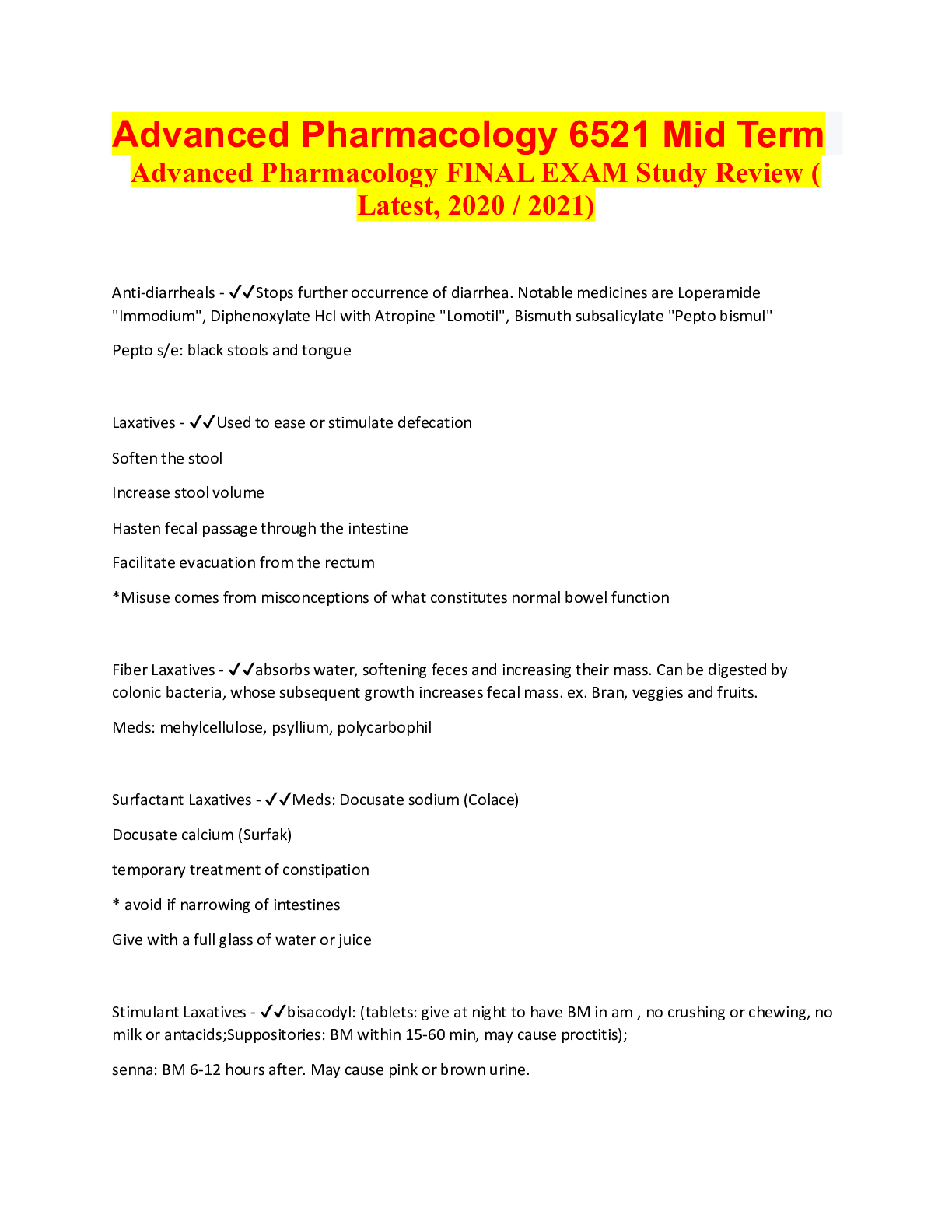
Reviews( 0 )
Document information
Connected school, study & course
About the document
Uploaded On
Jul 28, 2022
Number of pages
17
Written in
Additional information
This document has been written for:
Uploaded
Jul 28, 2022
Downloads
0
Views
39



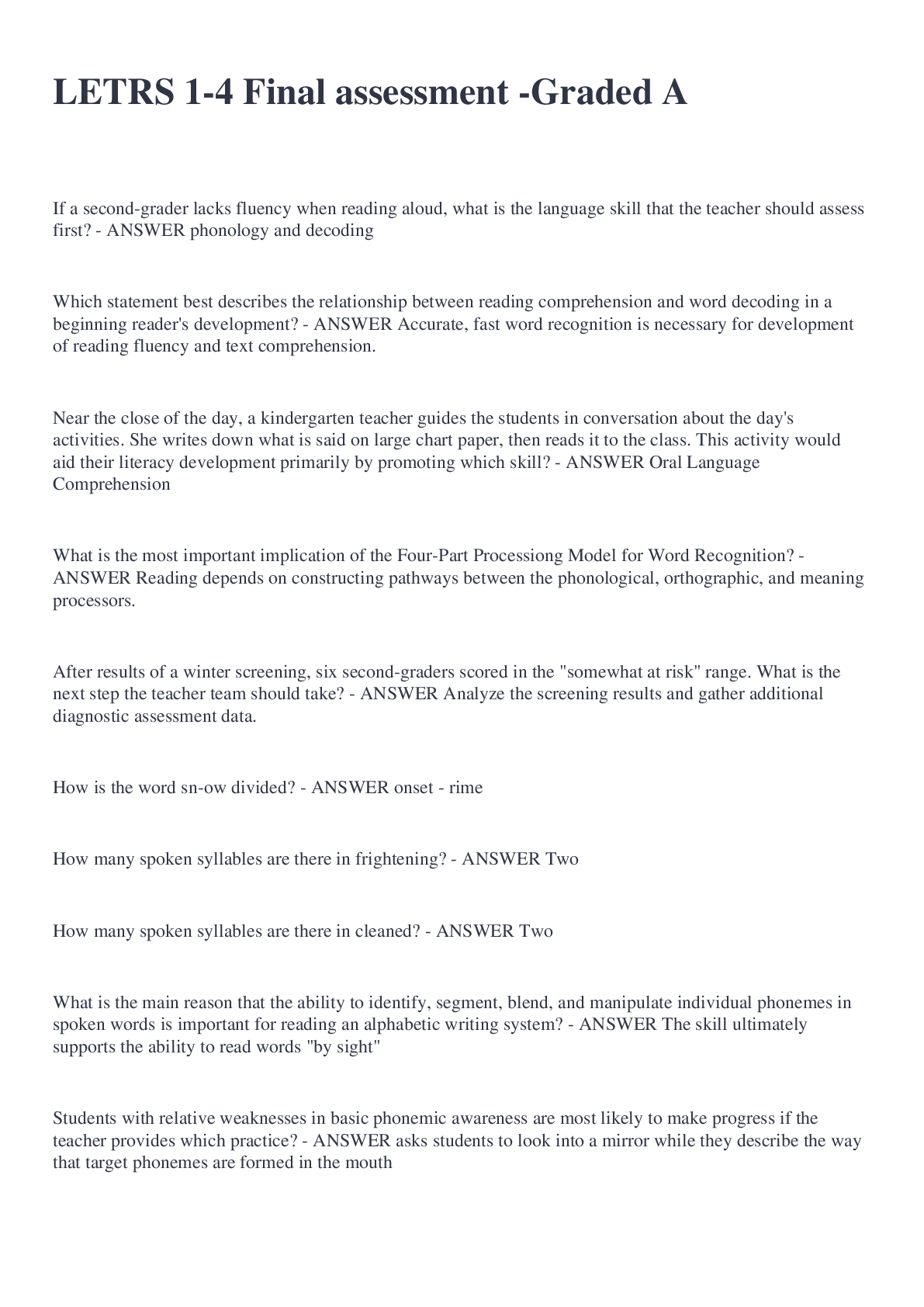


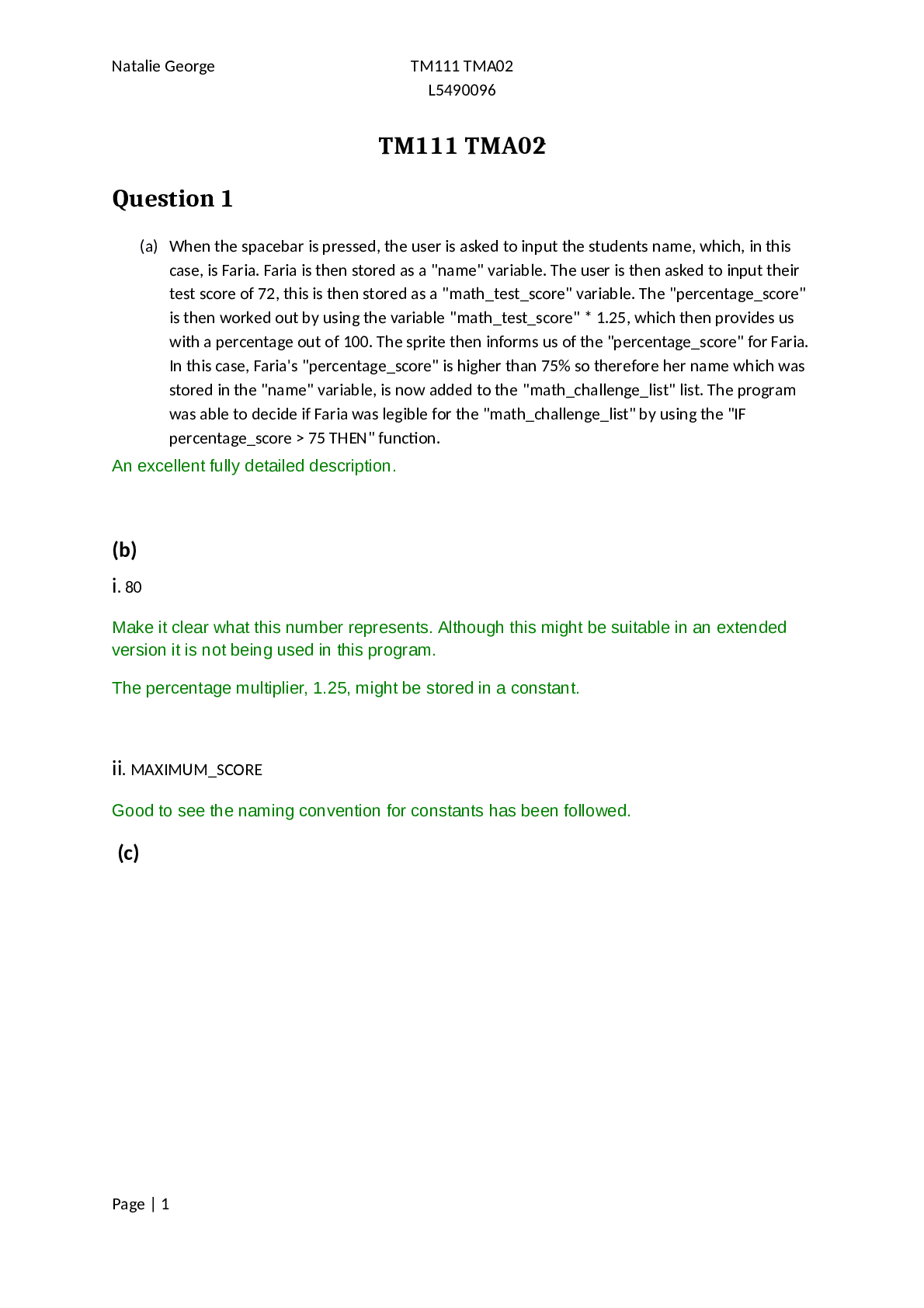


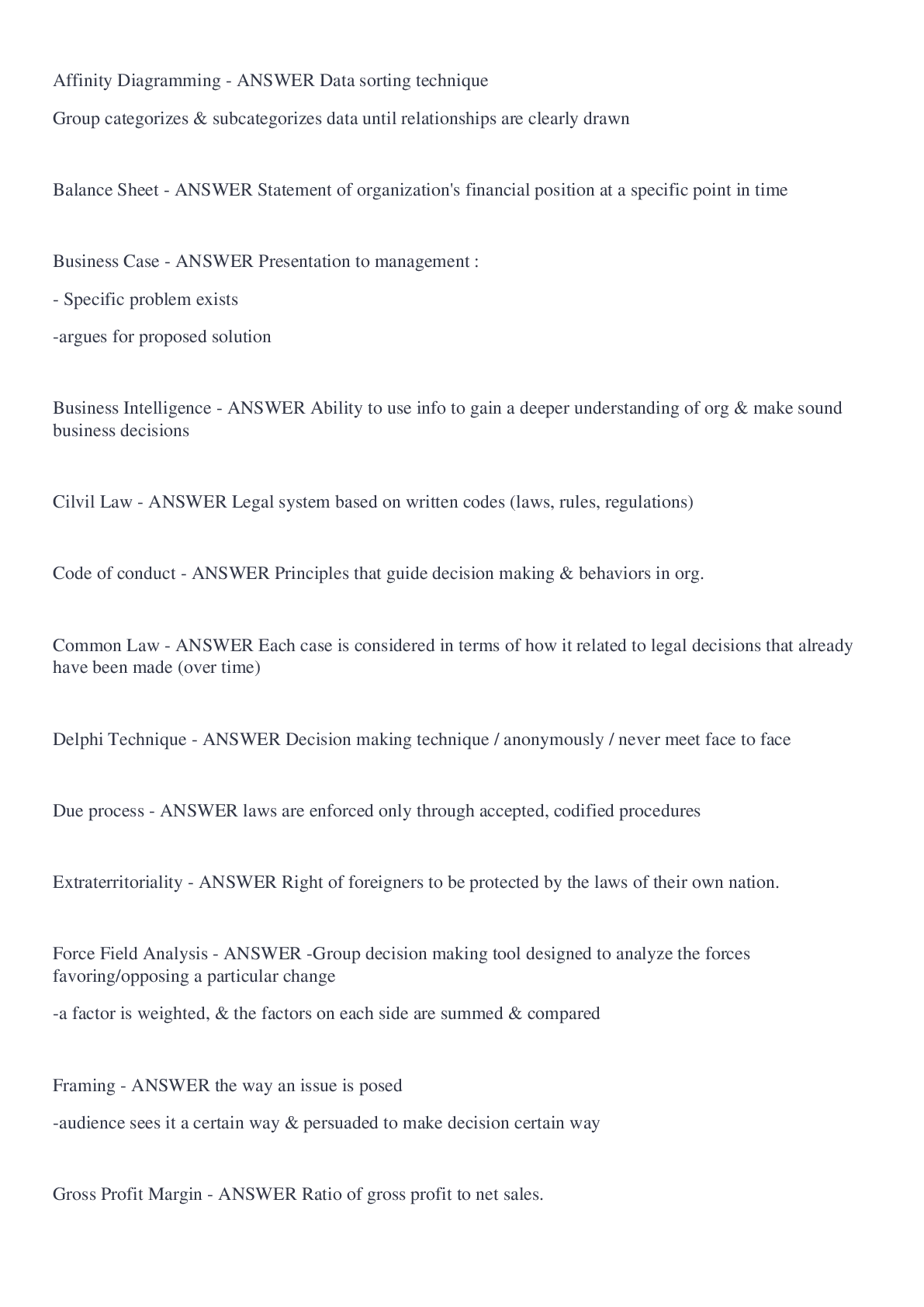

.png)

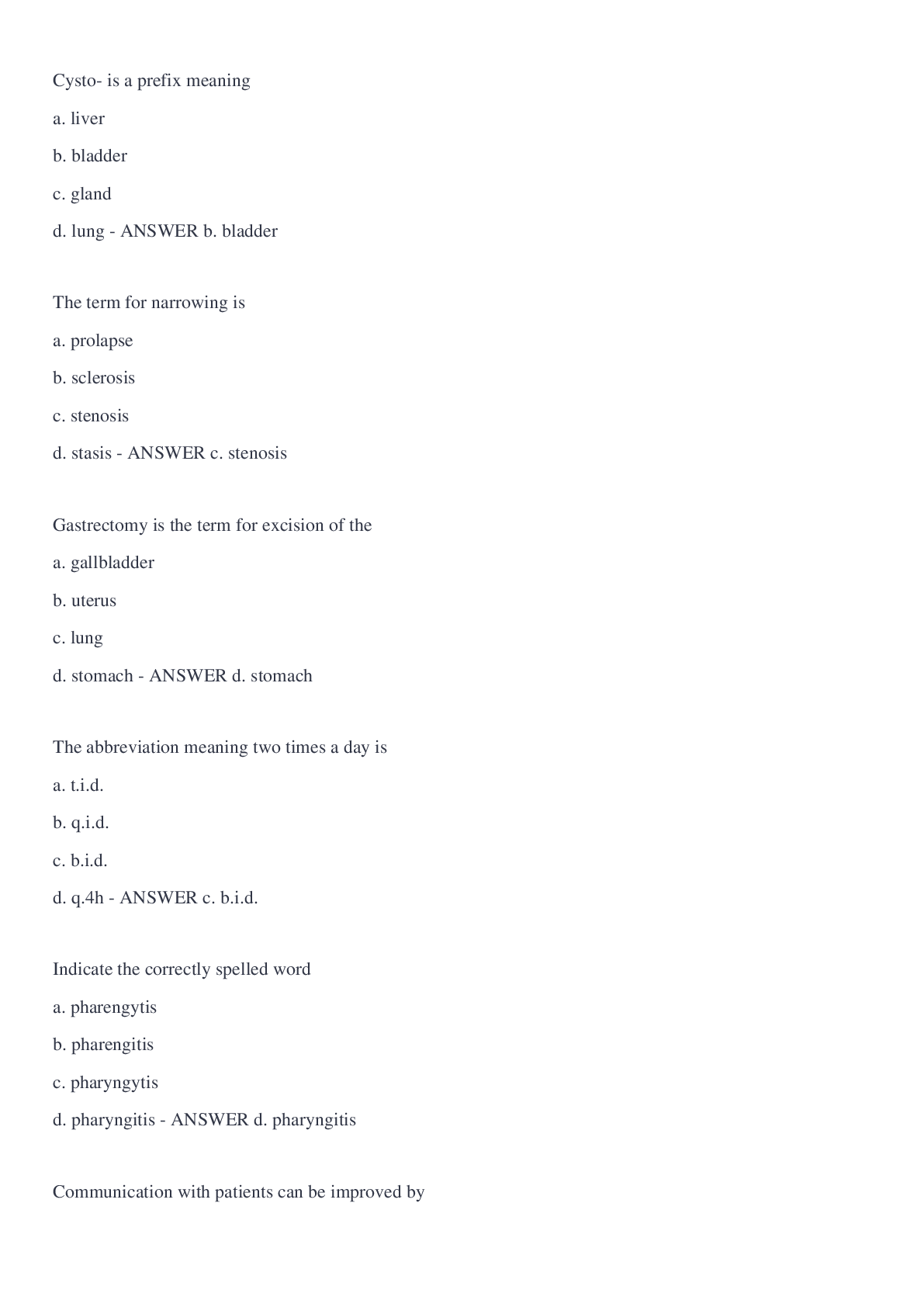


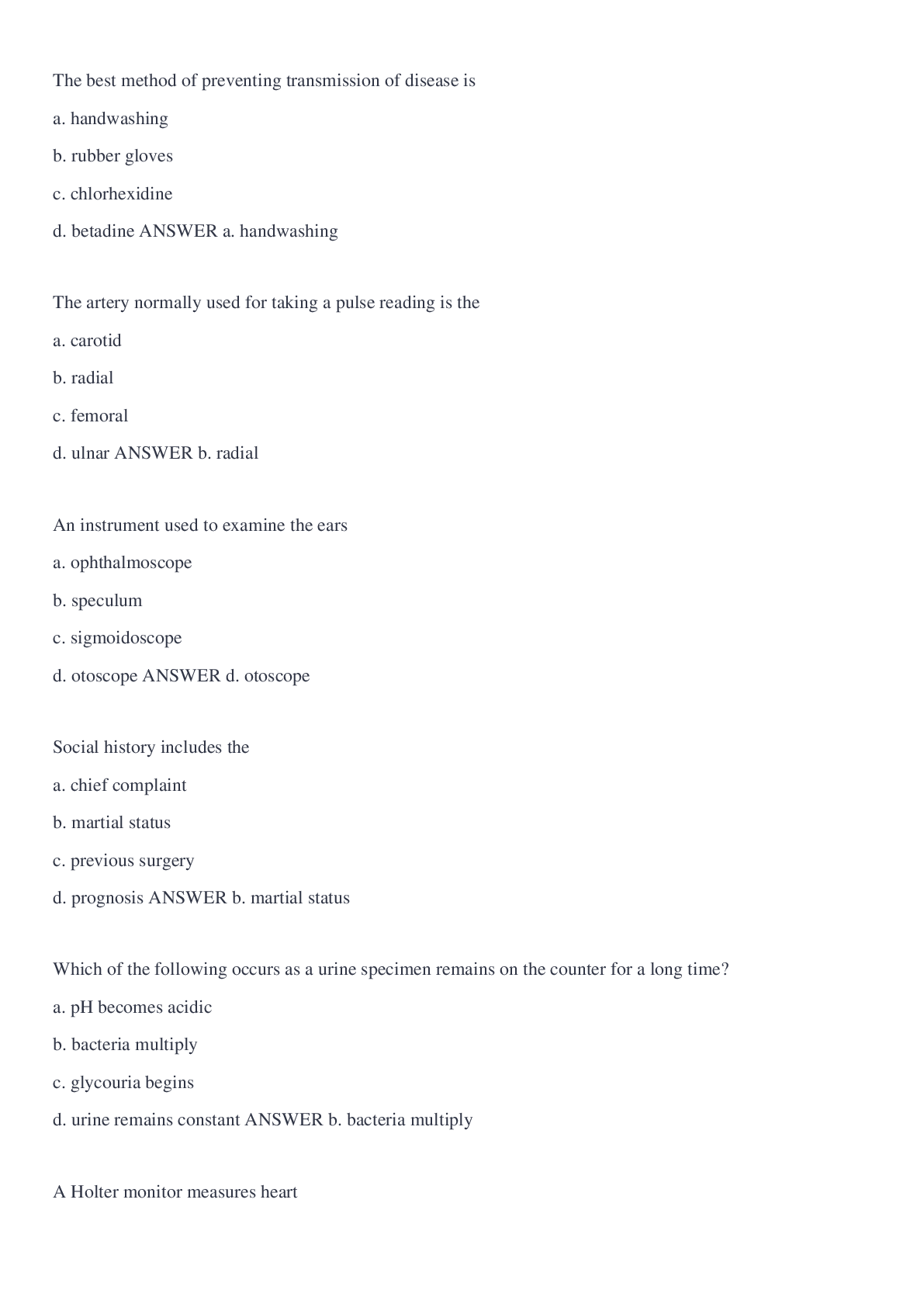
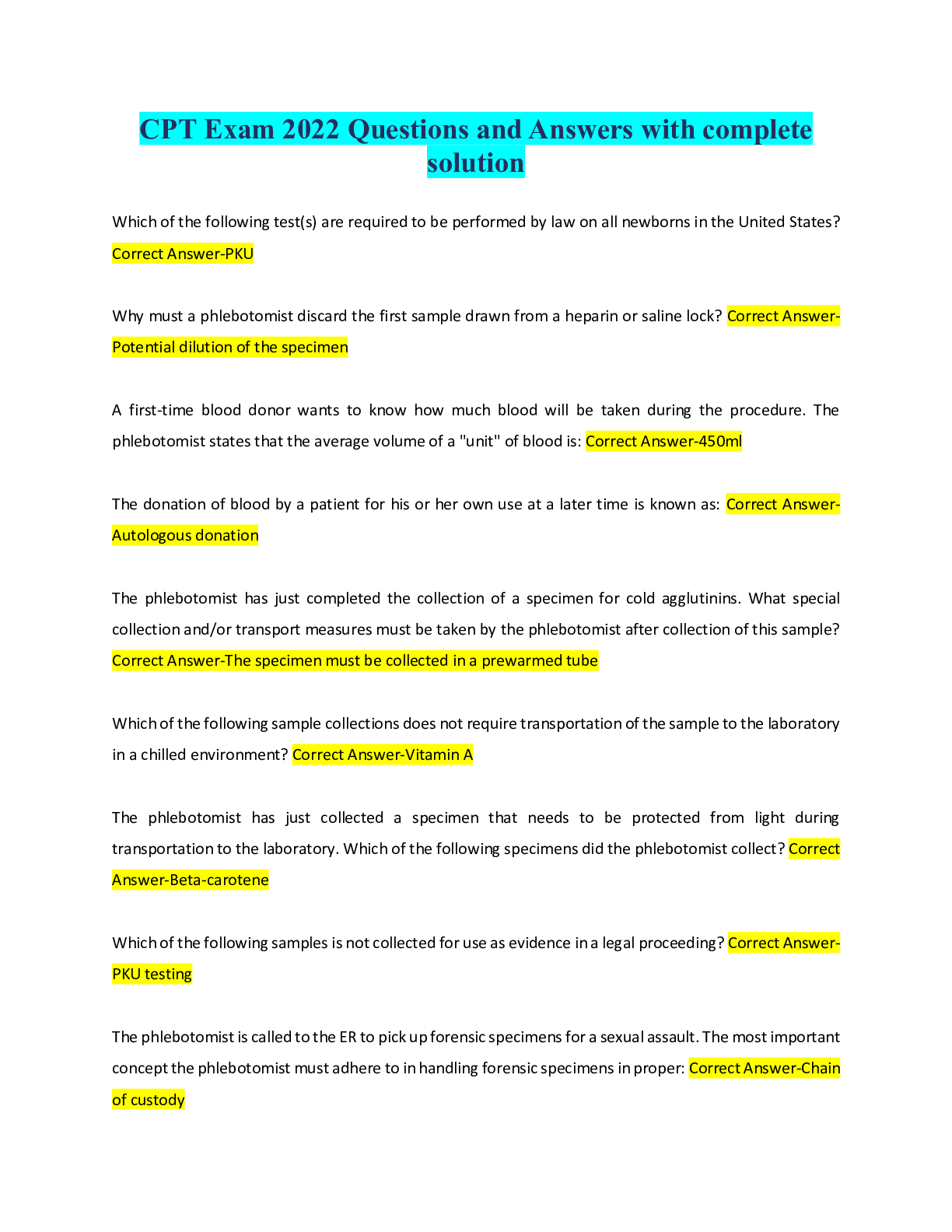
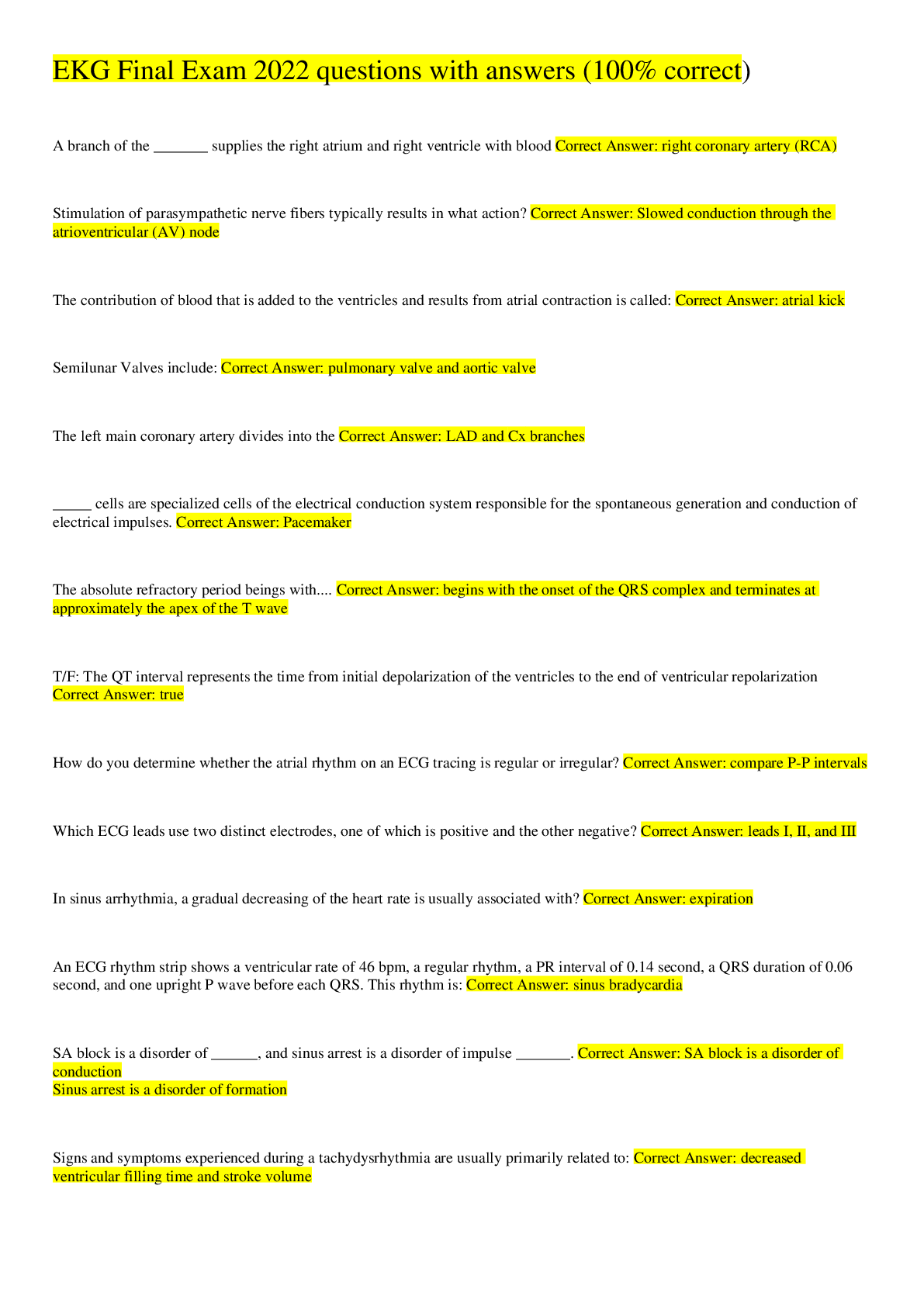
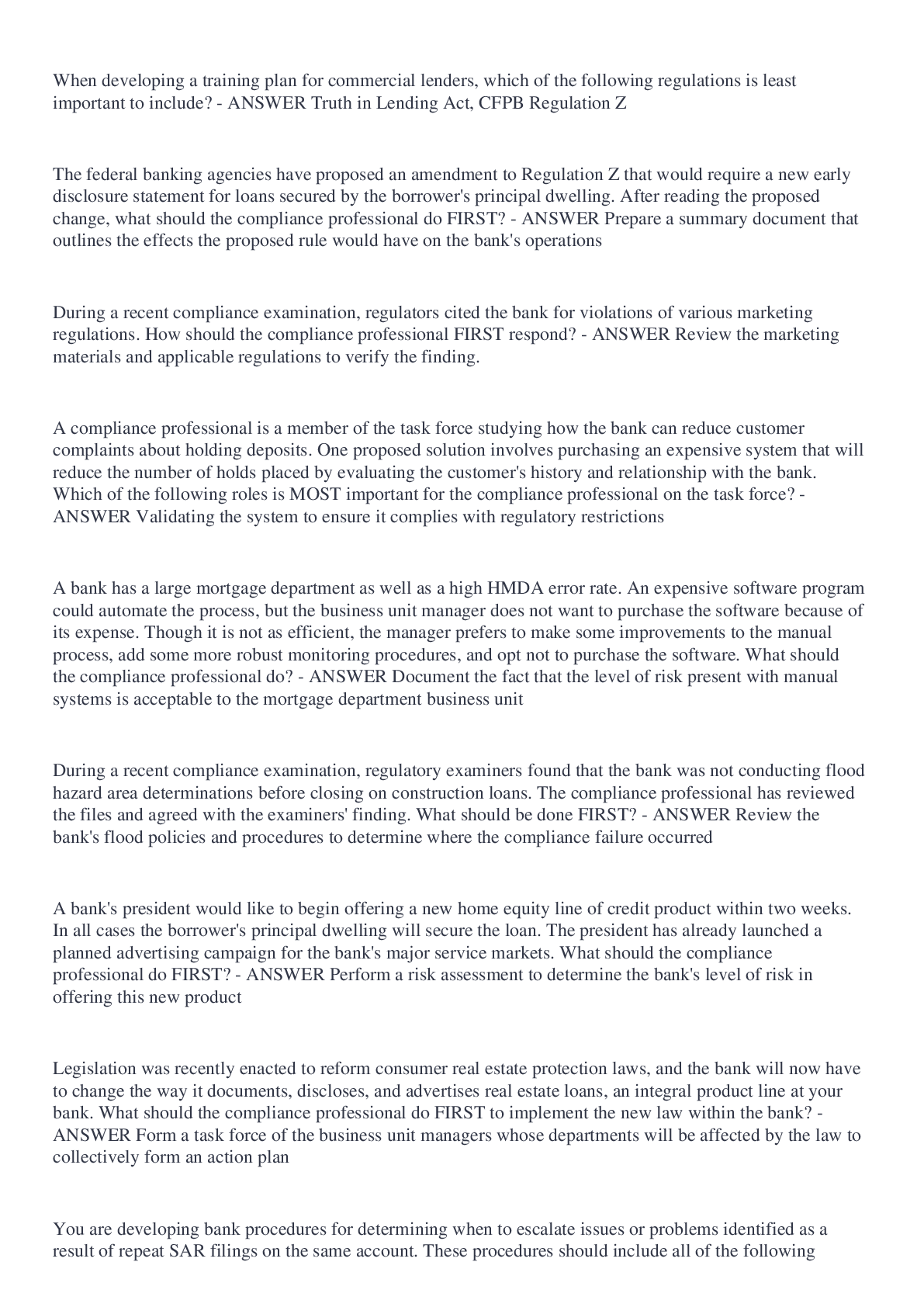
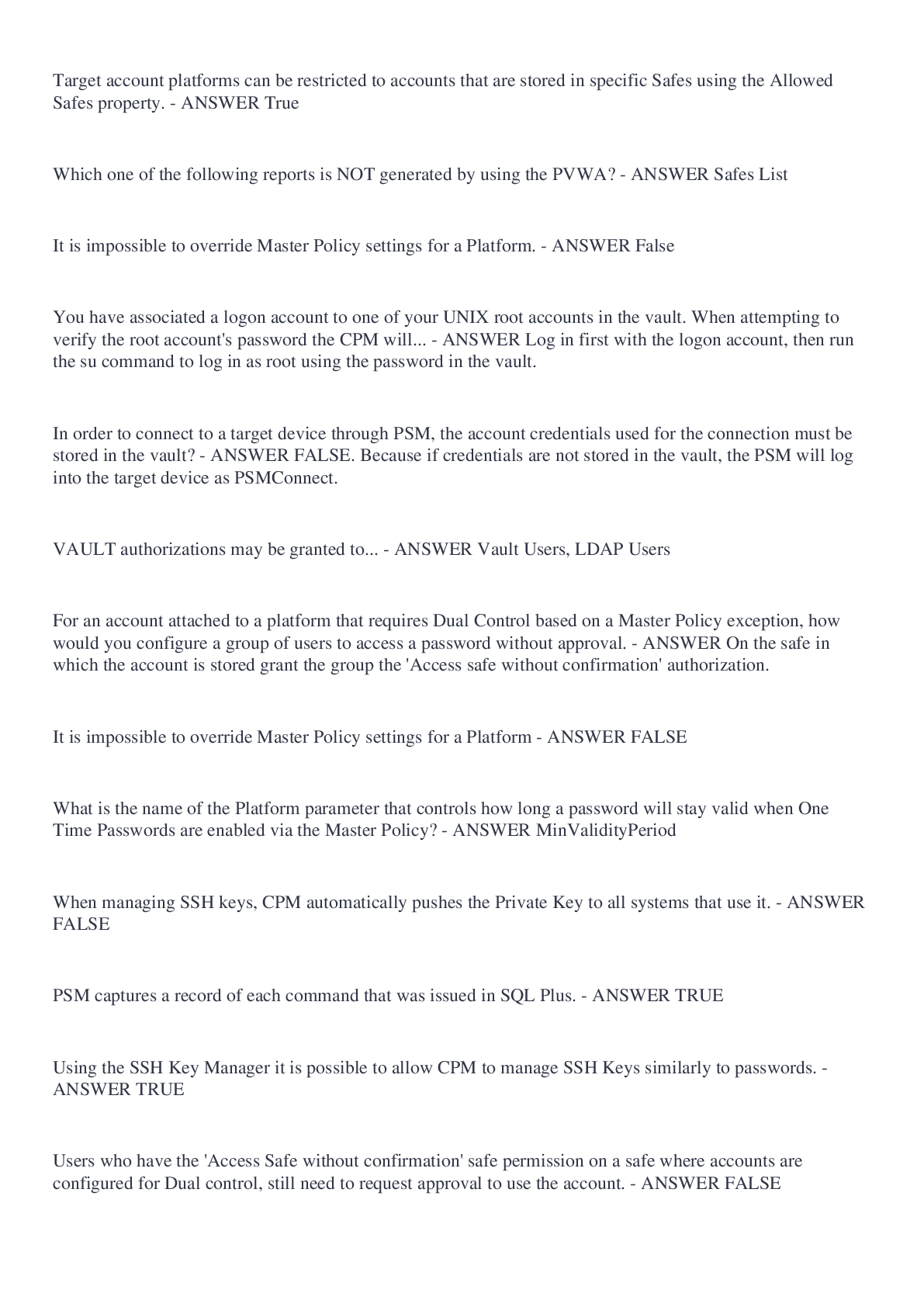

 Exam 2022 Questions & Answers.png)

.png)


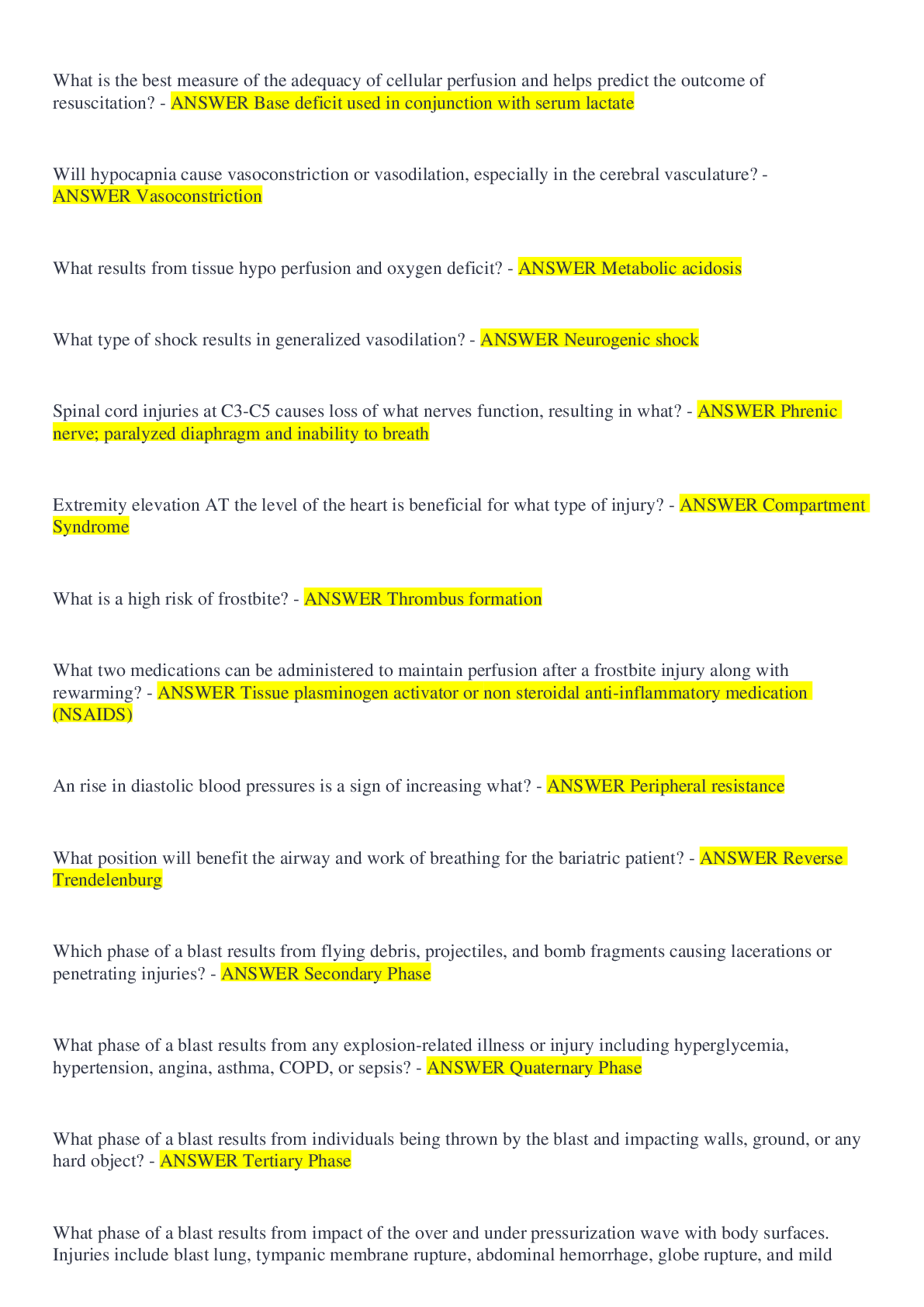
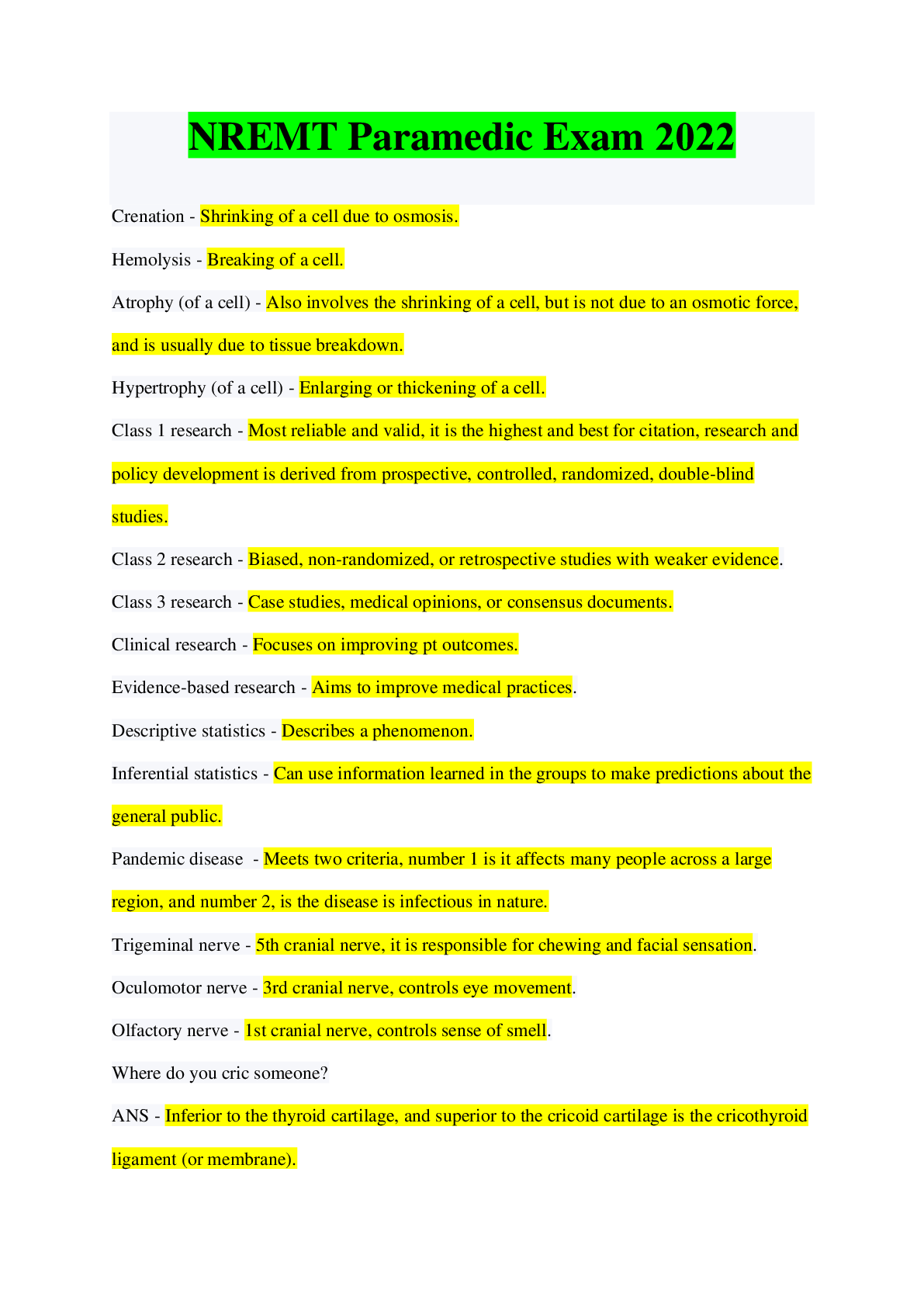
.png)

